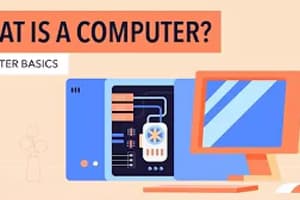Podcast
Questions and Answers
What is the primary function of a CPU in a computer system?
What is the primary function of a CPU in a computer system?
- To store data temporarily
- To display output on the monitor
- To provide input to the computer
- To execute instructions and perform calculations (correct)
What is the main difference between RAM and ROM?
What is the main difference between RAM and ROM?
- RAM is volatile, while ROM is non-volatile (correct)
- RAM is used for secondary storage, while ROM is used for primary storage
- RAM is slower, while ROM is faster
- RAM is used for input/output, while ROM is used for processing
What type of software is an operating system?
What type of software is an operating system?
- System software (correct)
- Malware
- Firmware
- Application software
What is the primary function of a hard disk?
What is the primary function of a hard disk?
Which generation of computers is characterized by the use of microprocessors?
Which generation of computers is characterized by the use of microprocessors?
Which component of a computer system is responsible for executing instructions?
Which component of a computer system is responsible for executing instructions?
What type of software is a web browser?
What type of software is a web browser?
Which of the following is an example of secondary memory?
Which of the following is an example of secondary memory?
What is the primary function of a scanner?
What is the primary function of a scanner?
Which generation of computers saw the development of personal computers?
Which generation of computers saw the development of personal computers?
Flashcards are hidden until you start studying
Study Notes
Characteristics of a Computer
- A computer is an electronic device that takes input, processes data, stores data, and produces output
- Computers can perform calculations and operations at high speed and accuracy
Components of a Computer System
- Central Processing Unit (CPU): executes instructions and performs calculations
- Memory: stores data and programs temporarily (RAM) and permanently (ROM)
- Storage Devices: holds data and programs permanently
- Input/Output (I/O) Devices: allow user interaction and data exchange
Memory
Primary Memory
- Random Access Memory (RAM): volatile, temporary storage of data and programs
- Read-Only Memory (ROM): non-volatile, permanent storage of data and programs
Secondary Memory
- Holds data and programs permanently, even when power is off
- Examples: hard disk, CD ROM, DVD, pen/flash drive, memory stick
Storage Devices
- Hard Disk: non-volatile, high-capacity storage device
- CD ROM (Compact Disc Read-Only Memory): non-volatile, optical storage device
- DVD (Digital Versatile Disc): non-volatile, high-capacity optical storage device
- Pen/Flash Drive: non-volatile, portable storage device
- Memory Stick: non-volatile, portable storage device
I/O Devices
- Keyboard: input device for typing data and commands
- Mouse: input device for interacting with graphical user interface
- Monitor: output device for displaying text and images
- Printer: output device for printing text and images
- Scanner: input device for scanning documents and images
- Web Camera: input device for capturing video and images
Types of Software
System Software
- Operating System (OS): manages computer hardware and provides software platform
- Device Drivers: software that controls and interacts with hardware devices
Application Software
- Programs that perform specific tasks or functions
- Examples: word processors, web browsers, games
- Mobile Applications: software designed for mobile devices, such as smartphones and tablets
Generations of Computers
Phases of Development
- First Generation (1946-1959): vacuum tubes, massive size, and limited functionality
- Second Generation (1959-1965): transistors, smaller size, and improved performance
- Third Generation (1965-1980): integrated circuits, microprocessors, and personal computers
- Fourth Generation (1980-1990): microprocessors, personal computers, and graphical user interface
- Fifth Generation (1990-present): artificial intelligence, internet, and mobile devices
Characteristics of a Computer
- A computer is an electronic device that takes input, processes data, stores data, and produces output
- Computers can perform calculations and operations at high speed and accuracy
Components of a Computer System
- Central Processing Unit (CPU): executes instructions and performs calculations
- Memory: stores data and programs temporarily (RAM) and permanently (ROM)
- Storage Devices: holds data and programs permanently
- Input/Output (I/O) Devices: allow user interaction and data exchange
Memory
Primary Memory
- Random Access Memory (RAM): volatile, temporary storage of data and programs
- Read-Only Memory (ROM): non-volatile, permanent storage of data and programs
Secondary Memory
- Holds data and programs permanently, even when power is off
- Examples: hard disk, CD ROM, DVD, pen/flash drive, memory stick
Storage Devices
- Hard Disk: non-volatile, high-capacity storage device
- CD ROM (Compact Disc Read-Only Memory): non-volatile, optical storage device
- DVD (Digital Versatile Disc): non-volatile, high-capacity optical storage device
- Pen/Flash Drive: non-volatile, portable storage device
- Memory Stick: non-volatile, portable storage device
I/O Devices
- Keyboard: input device for typing data and commands
- Mouse: input device for interacting with graphical user interface
- Monitor: output device for displaying text and images
- Printer: output device for printing text and images
- Scanner: input device for scanning documents and images
- Web Camera: input device for capturing video and images
Types of Software
System Software
- Operating System (OS): manages computer hardware and provides software platform
- Device Drivers: software that controls and interacts with hardware devices
Application Software
- Programs that perform specific tasks or functions
- Examples: word processors, web browsers, games
- Mobile Applications: software designed for mobile devices, such as smartphones and tablets
Generations of Computers
Phases of Development
- First Generation (1946-1959): vacuum tubes, massive size, and limited functionality
- Second Generation (1959-1965): transistors, smaller size, and improved performance
- Third Generation (1965-1980): integrated circuits, microprocessors, and personal computers
- Fourth Generation (1980-1990): microprocessors, personal computers, and graphical user interface
- Fifth Generation (1990-present): artificial intelligence, internet, and mobile devices
Studying That Suits You
Use AI to generate personalized quizzes and flashcards to suit your learning preferences.



